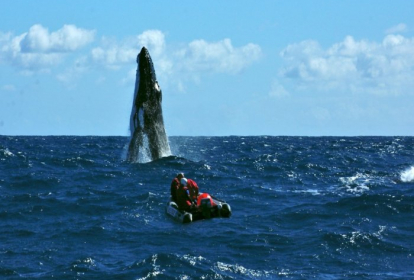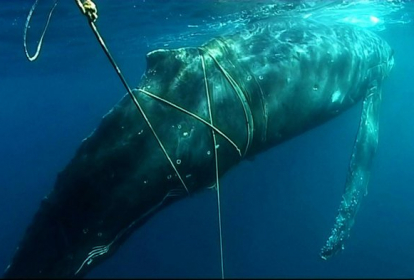Research suggests that over 300,000 whales and dolphins die annually due to entanglement in fishing gear, with additional unknown numbers also entangled in marine debris. This can have a devastating, long-term conservation impact on those populations that are already threatened, in some cases critically.
Entanglement is also a serious welfare issue. It can lead to drowning as trapped animals cannot reach the surface to breathe, to laceration and infection as heavy ropes bite through skin, and to starvation as animals towing heavy fishing gear cannot feed effectively.
There can also be serious economic consequences for the companies and communities who lose expensive fishing gear when it entangles a whale and is dragged away and lost. This can be especially devastating for 95% of the world's fishers, who are artisanal or small-scale fishers, supplying their families and villages.
Human safety is another very important concern. Handling any large, wild animal can be dangerous. Responding to one at sea, and that is likely to be injured and distressed, requires training and calm, careful implementation of safety protocols, minimising risk to the responders and conducting the most effective disentanglement possible, whatever the scenario.
The IWC Global Whale Entanglement Response Network
In response to these growing concerns, the IWC launched a Global Whale Entanglement Response Network in 2011. The immediate aim of the programme was to build safe and effective entanglement response capability around the world. The long-term goal is to prevent entanglements from happening in the first place.
The programme is a partnership with the Center for Coastal Studies (CCS), Provincetown, considered one of the global leaders in entanglement response. It is led by a Technical Advisor who works for both CCS and the IWC, and supported by an Expert Panel drawn from countries with long-standing and well-tested approaches to entanglement response.
Together, this group of experts has developed global Best Practice Guidelines and devised a two-day entanglement response training package. The training starts in the classroom, with information on data collection, relevant laws or regulations, and cetacean species present in the region. The training then moves onto the water, with practical sessions on using disentanglement tools and manoeuvring vessels close to large whales. All trainings are conducted with the permission, and ideally participation, of the relevant government authorities.
The Technical Advisor conducted the first training workshop in March 2012. Since then the training has been delivered on five continents, reaching over 1300 people from more than 36 countries. Trainees range from scientists, conservationists, whale watching operators and fishers to government representatives, regulators and members of naval or coast guard services. A ‘train the trainer’ apprenticeship programme has also been developed and led to the creation of six additional trainers, including native Spanish speakers.
As well as equipping regions, countries and coastlines with the skills to build their own entanglement response capability, and creating a global network of professional response teams, every participant is taught the importance of accurate and consistent data gathering. It is only through a concerted, international effort that enough data can be obtained to gain a more precise understanding of where, how and why entanglements happen, and this information is vital to achieve the long term goal of preventing entanglements happening in the first place.
The Global Whale Entanglement Response Network has shown how much can be achieved with very little financial investment and a great deal of international and inter-governmental collaboration. It has become a blueprint for two other IWC initiatives aiming to address cetacean bycatch and stranding.
Small Cetacean Entanglement
Responding to entangled dolphins and porpoises requires different approaches and protocols to those developed for large whale entanglements.
In 2024 the IWC Scientific endorsed new guidelines for responding to entangled, free swimming small cetaceans.
Read the Guidelines for Responding to Large Whale Entanglements
Read the Guidelines for Responding to Entangled, Free-Swimming Small Cetaceans
Additional Resources
- Click here to watch a short film about the 4-day team effort to free a humpback whale from 4000 lbs of entangled fishing gear.
- Click here to watch a short film showing each step in the operation to disentangle a humpback whale known as Crinkle.
- Click here for a short booklet about the IWC Entanglement Response Network.
- Click here for more information about members of the IWC Whale Entanglement Response Network.
- Click here for an image gallery on whale entanglement.
- Click here to watch a short film produced by the Center for Coastal Studies, the IWC's partner organisation in the Global Whale Entanglement Network.
- Click here to watch a short film about entanglement response from the Center for Coastal Studies, Provincetown, who partner the IWC in the Global Entanglement Response Network.
- Click here to watch a short film about the establishment of the Mexican Entanglement Response team, who were trained by the IWC Network.
- Click here to read an article on disentanglement by RABEN, the entanglement response team for Mexico, member of the Global Entanglement Response Network, and one of the first to receive training under the programme.


